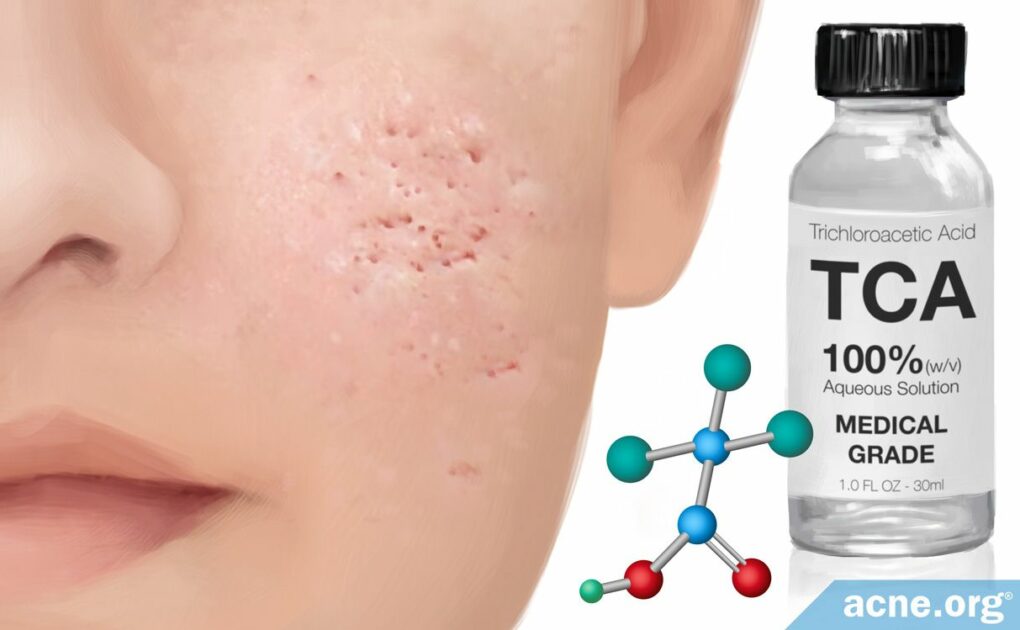Trichloroacetic Acid Reduces Scars by Promoting the Production of Collagen (and May Help Acne by Exfoliating the Skin)

The Essential Info
Trichloroacetic acid (TCA) is an acid used for the treatment of acne scars, most notably ice pick scars.
It works to treat acne scars by increasing the production of a skin protein called collagen, which fills in the indentation left by the scar.
The procedure is performed by a doctor or nurse who puts some TCA on the tip of a toothpick and presses it into each ice pick scar one by one. This creates a frosting on the skin and scabbing in the days after the procedure, followed by increased collagen production. It must usually be repeated several times to achieve a desired correction in ice pick scars.
Trichloroacetic acid is also sometimes used as an all-over scar-correction peel to reduce rolling or boxcar scars.
Can It Treat Acne? Yes. Similar to other acids used in chemical peels for acne, it should help, but from the few studies performed thus far, it appears to be less effective than a salicylic acid chemical peel for this purpose.

The Science
- How TCA Works on Acne Scars
- How TCA May Work on Acne
- TCA Side Effects
- How Well TCA Works on Acne Scars and Acne
- Summary
Trichloroacetic acid (TCA) is an acid mainly used for the treatment of acne scars, and not acne itself. However, 4 studies so far also show it may hold promise in treating acne itself as well.1-3
How TCA Works on Acne Scars
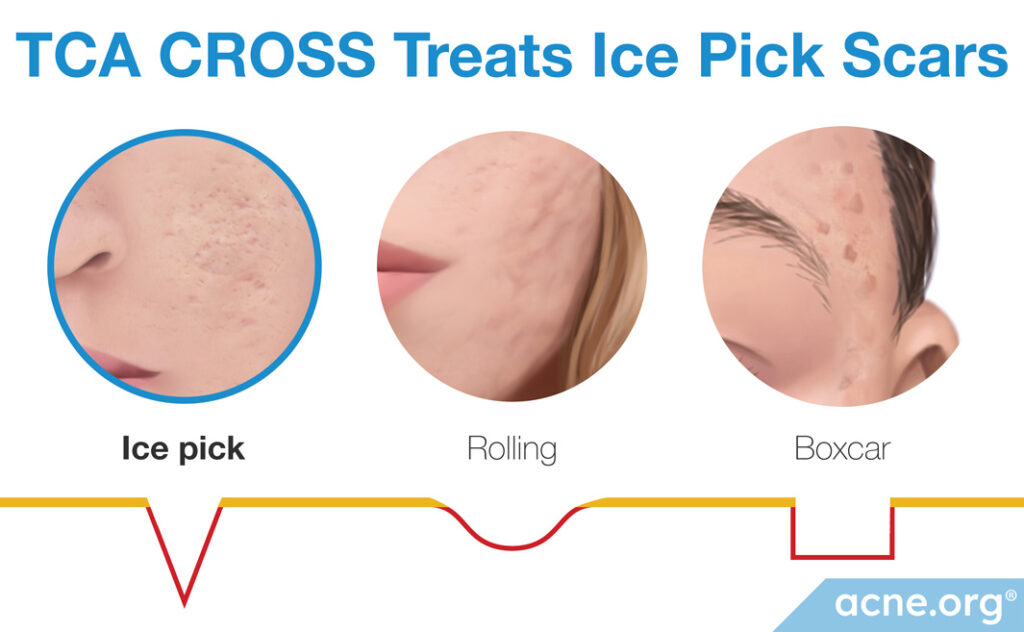
There are three main types of indented (atrophic) acne scars, and TCA is most commonly used to treat ice pick scars.
- Ice pick scars: Doctors treat ice pick scars by spot treating them one by one with TCA using a method called the TCA CROSS method.
- Rolling scars: Doctors can also use TCA as an all-over peel to treat rolling scars.
- Boxcar scars: Doctors can also use TCA as an all-over peel to treat boxcar scars.
How TCA CROSS works to treat icepick scars
TCA is most often used in a series of steps called the TCA CROSS (Chemical Reconstruction Of Skin Scars) method:
- A doctor applies TCA to the tip of a toothpick and presses it firmly into each ice pick scar one by one. After application, TCA causes skin proteins to stick to each other, causing cell death and creating a “white frost” appearance on the skin.
- A few days after treatment, the dead skin cells form a crust on the surface of the skin that looks like small scabs.
- In an attempt to repair itself, the skin is forced to produce more collagen, which can fill in the depression caused from the scar. Ultimately, the crust falls off the skin, which reveals newly formed skin layers and a less pronounced scar.
Ice pick scars are usually deep, and TCA is unlikely to immediately eliminate them. It usually takes multiple treatments over the course of several months before an acne scar will refill with collagen to an acceptable degree.
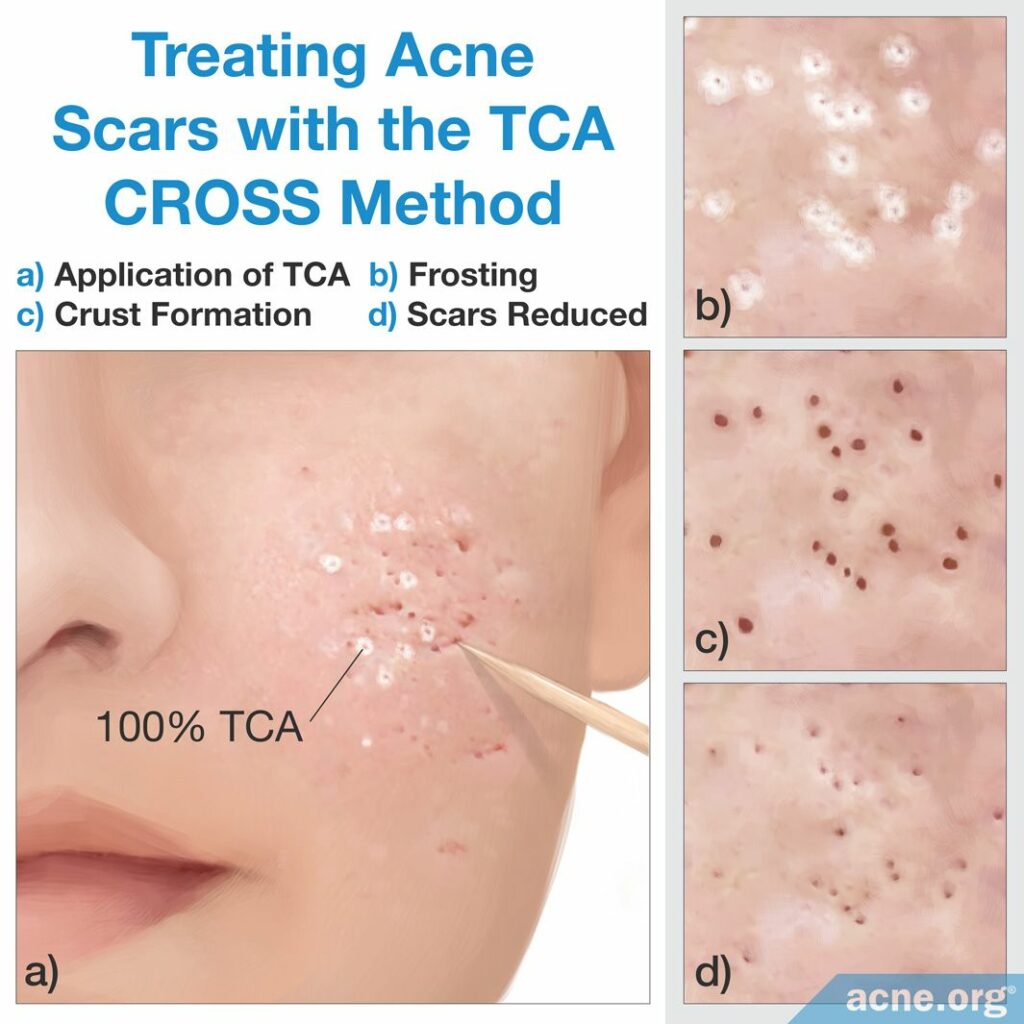
TCA Side Effects
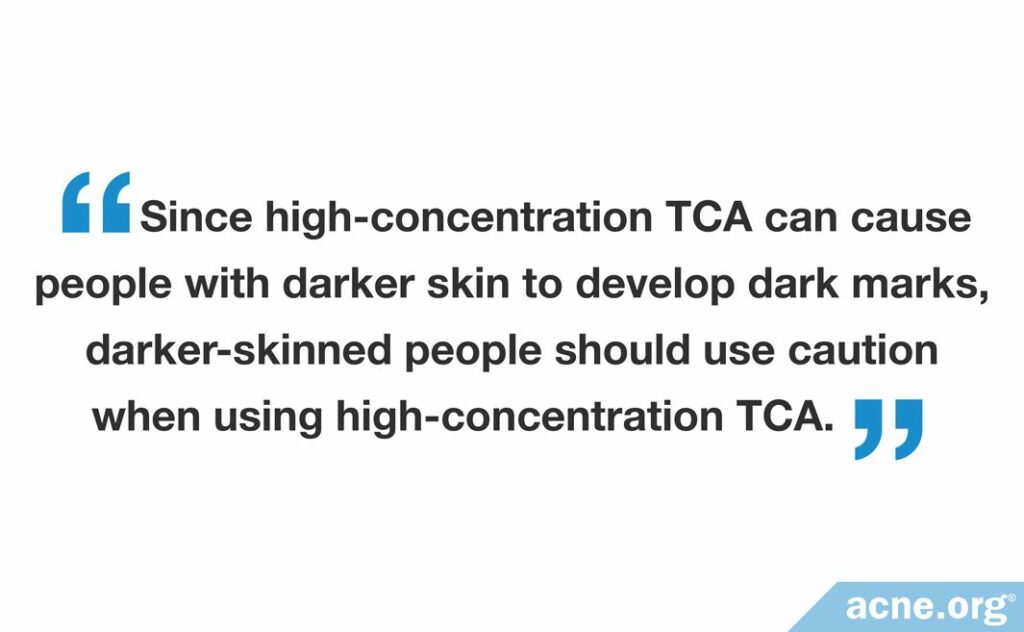
Trichloroacetic acid, whether used in the CROSS method or in an all-over peel, can cause mild side effects, including:
- Skin discomfort
- Mild or moderate stinging pain
- Skin redness
- Skin discoloration (mainly in darker-skinned individuals)
Since high-concentration TCA can cause people with darker skin to develop dark marks, darker-skinned people should use caution when using high-concentration TCA.1,4
How Well TCA Works on Acne Scars and Acne
Researchers have performed several studies investigating the effectiveness of TCA on the treatment of acne scars, both using the TCA CROSS method and as an all-over peel.
TCA CROSS method: Results show various concentrations of TCA producing very good to excellent improvement in most people after 3 – 6 treatments. A review article of 12 studies showed over 70% improvement in icepick scars in over 70% of patients after 4 sessions, spaced 2 weeks apart.
All-over peel: Results show various concentrations of TCA producing fair to good results in most people.
The takeaway here is that TCA works particularly well when used in the TCA CROSS method, specifically on ice pick scars, and may work less well when used as an all-over peel on general acne scarring.
Expand to read details of studies on the TCA CROSS method

A 2002 study published in Dermatologic Surgery investigated the effect of 65% or 100% TCA to treat acne scars. Researchers performed six TCA sessions over the course of six months at either 65% or 100% concentration to indented acne ice pick scars in 65 patients. For the 65% TCA treatment, 40% of patients reported good or excellent improvement of acne scars after the third treatment, which increased to 100% after the sixth treatment. For the 100% TCA treatment, 88% of patients reported good or excellent improvement of acne scars after the third treatment, which increased to 100% of patients reporting excellent improvement after the sixth treatment. Therefore, the researchers concluded that TCA is able to improve acne scars.4

A 2010 study published in the Journal of Cutaneous and Aesthetic Surgery investigated the effect of a 100% TCA treatment to treat ice pick acne scars in 10 patients over four treatment sessions. After the four sessions, the researchers found that 8 of the 10 patients saw 70% improvement in their acne scars, while the remaining 2 patients saw a 50 – 70% improvement in their scars.1

A 2013 study published in the Egyptian Journal of Dermatology and Venereology investigated the effect of a 50% TCA treatment on all three types of atrophic acne scars in 30 patients over three treatment sessions. The researchers found that the 50% TCA treatment was most effective at treating ice pick acne scars, followed by boxcar scars, and then rolling scars.5

A 2014 study published in the Indian Dermatology Online Journal investigated the effect of a TCA treatment combined with surgical subcision, which is a small incision on the surface of the skin, to treat all three types of atrophic acne scars in 12 patients. Generally, TCA treatments are most effective at treating ice pick scars, and are less effective at treating boxcar or rolling scars. This research found the combination of a TCA treatment with surgical subcision effectively treated ice pick, boxcar, and rolling scars. In this small study, results were graded as excellent in 6 patients, good in 3 patients, and fair in 1 patient.3
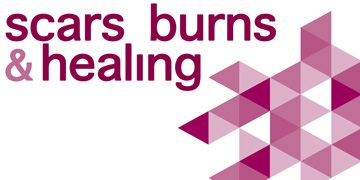
A 2017 article published in the journal Scars, Burns and Healing reviewed 12 studies that tested various chemical peels on acne scars. The authors of the article found that TCA CROSS achieved over 70% improvement in 73.3% of patients. Moreover, they concluded that ice pick scars seem to be particularly responsive to TCA CROSS. While the methods differed across studies, most studies gave patients 4 TCA CROSS treatments at intervals of 2 weeks.6

A 2021 study published in the Journal of Cosmetic Dermatology tested the efficacy of the TCA CROSS method on 6 patients with a total of 31 acne scars. The researchers compared the volume of the scars before as well as 3 months after the treatment. They found that one treatment with 85% TCA reduced the volume of individual acne scars by 26.3% on average—in other words, by about a quarter. The study authors wrote, “CROSS TCA technique has demonstrated efficacy in the treatment of acne scars after a single treatment.”7

A 2021 study published in the Journal of the College of Physicians and Surgeons Pakistan compared TCA CROSS to another acne scar treatment called intradermal platelet-rich plasma (PRP). Patients with acne scars were divided into 2 groups of 46 participants each:
- Group 1 received a treatment with 50% TCA once a month, for a total of 3 months.
- Group 2 received a PRP injection once a month, for a total of 3 months.
The researchers found that both treatments could reduce acne scars after just 1 treatment, but the most significant improvement occurred after 3 treatments. After all 3 treatments were completed, the PRP produced better results than the TCA CROSS.8
Expand to read details of studies on using an all-over TCA peel to treat acne scars

A 2014 study published in the Journal of Cutaneous and Aesthetic Surgery investigated the effect of a 15% all-over TCA peel to clear acne scars when used over the entire face instead of as a spot treatment. To perform this study, the researchers applied the 15% TCA peel every two weeks for six peeling sessions in 50 patients with atrophic acne scars. The researchers found that all 50 patients reported at least some improvement in acne scars, but that the most significant improvement occurred in patients who began the study with less severe scars.9
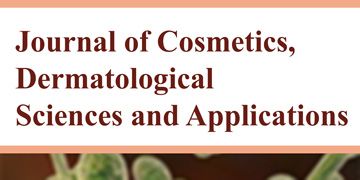
A 2013 study in the Journal of Cosmetics, Dermatological Sciences and Applications tested the efficacy of a 35% all-over TCA peel on 12 patients with medium-to-dark skin and acne scars. Patients received 3 peel treatments. The researchers followed up with the patients every 2 weeks for 12 weeks after the start of treatment and then every 4 weeks for another 12 weeks. The scientists found a significant improvement in acne scars after 3 all-over TCA peel treatments.10

A 2015 study published in the Journal of Cutaneous and Aesthetic Surgery compared the efficacy of 20% TCA together with Jessner’s solution and 20% TCA alone for the treatment of acne scars. Patients were divided into 2 groups, each consisting of 25 patients. The first group was treated with Jessner’s peel followed by 20% TCA and the second one was treated with 20% TCA peel alone. Both groups showed equal improvement in acne scars. For example, in the patients treated with TCA peel alone, mild improvement of acne scars occurred in 32% of cases, moderate improvement in 40% of cases, and marked improvement of acne scars in 28% of cases. Even though TCA peel alone was just as effective as the combination of Jessner’s solution and TCA peel, the authors concluded that adding Jessner’s solution to TCA peel might be beneficial for the treatment of acne scars since it may minimize post-inflammatory hyperpigmentation.11
How TCA May Work on Acne
Acne is a disease that begins with clogged pores. Chemical peels are acids that work by exfoliating the top layer of accumulated dead skin cells, increasing skin turnover, and reducing clogged pores.
There are several types of acids used in chemical peels, most notably glycolic acid and salicylic acid, and TCA likely works in similar ways to these other acids. However, because TCA is not typically used in chemical peels for acne, we don’t have enough concrete evidence to know for certain how TCA works if it is applied as an all-over chemical peel treatment for acne.
Researchers have only performed 4 studies on the ability of TCA to treat acne. All these studies found that an all-over TCA peel improved acne to some degree. However, 2 of the 4 studies only gave descriptions like “significant improvement” but did not provide any numbers for how much acne actually improved.10,12 The third study found that 4 sessions of all-over TCA peels reduced the number of acne lesions by 69%.13 Finally, the fourth study reported that 6 sessions of all-over TCA peels reduced the number of acne lesions by about half.14
Expand to read details of studies on using an all-over TCA peel to treat acne

A 2013 study in the Journal of Cosmetics, Dermatological Sciences and Applications tested the efficacy of a 35% all-over TCA peel on 18 acne patients with medium-to-dark skin. The patients received 1 peel treatment. The researchers followed up with the patients every 2 weeks for 12 weeks after the start of treatment and then every 4 weeks for another 12 weeks. The scientists found that the 35% TCA peel significantly reduced the number of acne lesions 2 weeks after the treatment.10

A 2015 study published in Dermatologic Surgery compared the effectiveness of a 25% TCA peel to that of a 30% salicylic acid peel. Salicylic acid is a common acne treatment. This was done as a split-face study every 2 weeks for 2 months. This study found that 85% of 20 patients who received the TCA peel reported some level of acne improvement, compared to 95% of 20 patients who received the salicylic acid peel. However, the researchers did find that the TCA peel was better than salicylic acid at treating non-inflammatory lesions like whiteheads and blackheads, improving them in 80% of patients. Still, they concluded that, overall, TCA is less effective than salicylic acid.12

A 2015 study in the journal Acta Medica Marisiensis compared the efficacy of a 20% all-over TCA peel to 15% azelaic acid gel for treating acne. The study included 51 patients with mild-to-moderate acne. Of these patients, 24 patients underwent 4sessions of TCA peels at 2-week intervals, while 27 patients received azelaic acid gel treatments twice a day for 8 weeks. At the end of the treatment, the number of acne lesions decreased by 69% in the patients treated with TCA peels and by 32% in the patients treated with azelaic acid gel. The researchers wrote, “20% TCA peels showed superior results than 15% azelaic acid gel. Additionally, 96% of patients who underwent TCA peels were very satisfied with the results obtained.”13
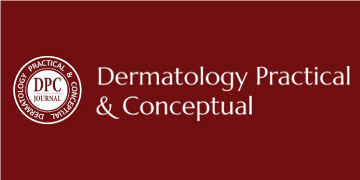
A 2021 study published in the journal Dermatology Practical & Conceptual compared a 25% all-over TCA peel to a 30% salicylic acid peel for the treatment of mild-to-moderate acne. The study included 50 patients divided into 2 groups: the first group underwent 6 sessions of TCA peels spaced 2 weeks apart, while the second group underwent 6 sessions of salicylic acid peels spaced 2 weeks apart. After all the sessions were completed, the researchers compared the number of acne lesions on the patients’ faces. They found that both types of peels had decreased the number of acne lesions about equally. When it came to TCA, 6 all-over-peel treatments decreased whiteheads and blackheads by 53.91%, papules by 56.68%, and pustules by 59.93%. In other words, the all-over TCA peels reduced the number of each type of acne lesion by about half.14
Summary
Trichloroacetic acid (TCA) is a chemical treatment applied by a professional for the treatment of acne scars. It works to treat acne scars by stimulating the production of the skin protein, collagen, which helps to fill in the depression.
Less is known about using TCA to treat acne, but research investigating the effect of TCA on acne has found that TCA is somewhat effective at clearing acne. However, it is less effective than salicylic acid.
References
- Bhardwaj, D. & Khunger, N. An assessment of the efficacy and safety of CROSS technique with 100% TCA in the management of ice pick acne scars. J Cutan Aesthet Surg 3, 93 – 96 (2010). https://www.ncbi.nlm.nih.gov/pmc/articles/PMC2956965/
- Fabbrocini, G. et al. Acne scars: Pathogenesis, classification and treatment. Dermatol Res Pract 2010, 1 – 13 (2010). https://www.ncbi.nlm.nih.gov/pubmed/20981308
- Kaur, J. & Kalsy, J. Subcision plus 50% trichloroacetic acid chemical reconstruction of skin scars in the management of atrophic acne scars: A cost-effective therapy. Indian Dermatol Online J 5, 95 – 97 (2014). https://www.ncbi.nlm.nih.gov/pmc/articles/PMC3937506/
- Lee, J. B., Chung, W. G., Kwahck, H., Lee, K. H. & Monheit, G. Focal treatment of acne scars with trichloroacetic acid: Chemical reconstruction of skin scars method. Dermatol Surg 28, 1017 – 1021 (2002). https://www.ncbi.nlm.nih.gov/pubmed/12460296
- El Garem, Y. F., Ghabrial, E. E. & Embaby, M. H. Chemical reconstruction of skin scars technique using trichloroacetic acid in different types of atrophic acne scars. Egypt J Dermatol Venereol 33, 37 – 41 (2013). http://www.ejdv.eg.net/article.asp?issn=1110-6530;year=2013;volume=33;issue=2;spage=37;epage=41;aulast=Garem
- Kravvas, G. & Al-Niaimi, F. A systematic review of treatments for acne scarring. Part 1: Non-energy-based techniques. Scars Burn Heal 3, 2059513117695312 (2017). https://www.ncbi.nlm.nih.gov/pubmed/29799567
- Horovitz, T., Salameh, F., Shehadeh, W., Koren, A. & Artzi, O. Painting CROSS TCA technique: Modification of the CROSS method for the treatment of atrophic acne scars—Case series. J Cosmet Dermatol 21, 327-330 (2022). https://pubmed.ncbi.nlm.nih.gov/34773721/
- Mumtaz, M., Hassan, T., Shahzad, M. K., Hanif, N., Anwar, S. & Anjum, R. Comparing the efficacy of intra-dermal platelet rich plasma (PRP) versus 50% trichloracetic acid (TCA) using CROSS technique for atrophic acne scars. J Coll Physicians Surg Pak31, 55-59 (2021). https://pubmed.ncbi.nlm.nih.gov/33546534/
- Garg, S. & Baveja, S. Combination therapy in the management of atrophic acne scars. J Cutan Aesthet Surg 7, 18 – 23 (2014). https://www.ncbi.nlm.nih.gov/pubmed/24761094
- Sharquie, K., Noaimi, A. & Al-Janabi, E. Treatment of active acne vulgaris by chemical peeling using TCA 35%. Journal of Cosmetics, Dermatological Sciences and Applications 3, 32-35 (2013). https://m.scirp.org/papers/39965
- Puri, N. Efficacy of modified Jessner’s peel and 20% TCA versus 20% TCA peel alone for the treatment of acne scars. J Cutan Aesthet Surg 8, 42-45 (2015). https://www.ncbi.nlm.nih.gov/pubmed/25949022
- Abdel Meguid, A. M., Elaziz Ahmed Attallah, D. A. & Omar, H. Trichloroacetic acid versus salicylic acid in the treatment of acne vulgaris in dark-skinned patients. Dermatol Surg 41, 1398 – 1404 (2015). https://www.ncbi.nlm.nih.gov/pubmed/26551771
- Al Hussein, S., Buicu, F., Maier, D., & Hussein, H., Ciurba, A., Al Hussein, H., & Dogaru, M. Efficacy of trichloroacetic acid peel versus 15% topical azelaic acid gel in the treatment of acne vulgaris – a comparative study. Acta Medica Marisiensis 61, 25-30 (2015). http://actamedicamarisiensis.ro/eficacy-of-trichloroacetic-acid-peel-versus-15-topical-azelaic-acid-gel-in-the-treatment-of-acne-vulgaris-a-comparative-study/
- Dayal, S., Singh, S. & Sahu, P. Efficacy and safety of 25% trichloroacetic acid peel versus 30% salicylic acid peel in mild-to-moderate acne vulgaris: A comparative study. Dermatol Pract Concept 11, e2021063 (2021). https://pubmed.ncbi.nlm.nih.gov/34123563/
 Acne.org Products
Acne.org Products